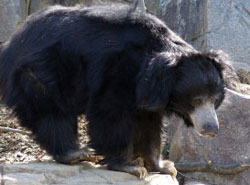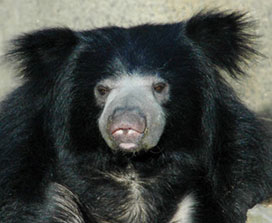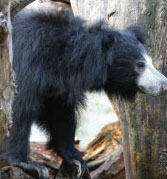The only bear species in our country
Last week we introduced you to a cute and cuddley member of the
Ursidae family, the beautiful spectacled bear. Most of you must have
enjoyed reading about this animal species because bears have always had
a strong appeal, especially for children. Today too we like to enlighten
you about yet another member of the Ursidae family. But unlike the
spectacled bear, which is native to South America, the sloth bear is
found in our very own country too. In fact, it is the only bear species
found in our country.
 Those
of you who have visited some of our wild life sanctuaries may have
already seen this animal. sloth bears can also be seen at the Dehiwala
Zoological Gardens. Those
of you who have visited some of our wild life sanctuaries may have
already seen this animal. sloth bears can also be seen at the Dehiwala
Zoological Gardens.
The sloth bear, Melursus ursinus is a mammal of the bear family-"ursidae",
and is an omnivore. (feeds on both plants and animals)Apart from our
country, sloth bears are found in neighbouring countries like, India,
Nepal, Bhutan and Bangladesh. There are two identifiable types of these
bears: the Sri Lankan sloth bear Melursus ursinus inornatus and the
Indian sloth bear M. u. ursinus. It is also called the lip bear, the
five-fingered sloth and the honey bear by some. In our country the bear
is known as the walaha in Sinhala and karadi in Tamil. However, it is
the sickle shaped claws which have an unmistakable resemblance to the
claws of the animal called "sloth" that has given this bear its common
name the sloth bear.

The sloth bear prefers forested areas, scrub jungles and grasslands,
predominantly at lower elevations. (Such as 'Yala' and the Udawalawe
national parks). They favour drier forests and prefer areas with rocky
outcrops. As is the case for many species, the destruction of sloth
bears' habitats is a major cause for their rapidly declining numbers.
According to wildlife experts, the number of sloth bears remaining in
the wild has fallen dramatically and even though exact numbers aren't
available, it is estimated that the population ranges between
7,000-10,000. However, it is not merely habitat loss that is the cause
of the dwindling numbers of sloth bears. The destruction of their source
of favourite food; termite mounds for fine soil for tennis courts and
also hunting them for body parts are other reasons.
Did you know that in India,these bears are poached for their gall
bladders and also other parts which are highly valued in traditional
Chinese medicine? It is estimated that in the late 1970s parts from up
to 1,500 bears a year were sold in Japan. Even though these bears are
protected by international and national laws, the capture of live bears
continues to this day.
They have also been hunted because of their reputation for aggression
and crop destruction. But these bears are generally not aggressive.
Their sense of smell is well developed, but as their sight and hearing
are poor, this paves the way for humans to draw close to the bears
without their knowledge. So, when suddenly they feel threatened, they
naturally defend themselves, perhaps even becoming very aggressive. Even
though they are excellent climbers, they do not climb trees to escape
danger. Surprisingly, these bears have been described as shy, by
researchers.
Now, let's check out their appearance because though they generally
look like the bears we described last week, there are many differences
.The size and weight of the sloth bear varies with the availability of
food, They are generally smaller than Himalayan black bears. They
average a length of 140-170 centimetres, a height of 85
 centimetres
and a weight between 125-145 kilograms as adults, the male being larger.
The body is covered with long, shaggy black hair with slightly less hair
on the belly area and under the legs. A whitish or cream coloured 'V',
"Y" or 'U' shaped mark adorns the chest. centimetres
and a weight between 125-145 kilograms as adults, the male being larger.
The body is covered with long, shaggy black hair with slightly less hair
on the belly area and under the legs. A whitish or cream coloured 'V',
"Y" or 'U' shaped mark adorns the chest.
The body is slender and the limbs are designed to climb trees as well
as to dig the ground for one of their favourite food, termites. Like
other bears and humans they are able to walk on the entire foot.
Their ears are visible and the tails which are 15-18 cm (6-7 inches)
long, the longest in the bear family, are hidden in the long hair.
Sloth bears are omnivorous and although their diet typically includes
a large proportion of insect foods, with termites and ants high on their
preference list, their diet includes leaves, honey, flowers, and fruits
as well. They are also known to eat carrion, but are not predatory in
nature. During the months of March through June, fruits are more common
and on occasion may make up 50 per cent of these bears' diet.
Would you believe that sloth bears can close their nostrils
completely at their own will?. The elongated nose and muzzle are
specially designed to "hoover up"(vacuum) termites and ants. Termites
are a very secure food source, as they are present all year round.
They relish termite or bee nests and will do everything to get at
them. While raiding termite nests these bears insert their long snouts
into the nest, rip open the nest with their long claws, blow away the
earth and dust, and then feast on their prize, by vacuuming the termites
into their mouths. This sucking action is also accompanied with a series
of puffings and belching which can be heard over a hundred metres away.
The ability to voluntarily open and close their nostrils prevents the
inhalation of dust during this process.

When populated areas are nearby, sloth bears tend to feed on
cultivated crops like sugar cane and maize.They are mainly nocturnal.
(active at night).. During the day they sleep in caves, especially caves
by river banks. They do not hibernate, but do have a period of
inactivity during the rainy season.
Sloth bears share a habitat with many predatory carnivores such as
tigers, leopards and wild dogs and are constantly under pressure from
natural predation. The size of the home range varies with the amount of
food to be found within that region. Not much research has been
conducted into the extent of the home range, it has been established
that these bears do like to share it with other members of their species
.
Information on the reproductive behaviour of these bears varies. In
Sri Lanka breeding appears to occur all year around whilst in India the
breeding period is restricted to June and July.
After a gestation (pregnancy term) of six to seven months, the cubs
are born in the dry season (December to January). Sloth bears give birth
to one or two 300-500 gram cubs. Mothers usually give birth to her cubs
in an underground den. After birth, the cubs stay blind for about three
weeks. After a period of about four to five weeks, the young leave the
den. If the cub survives the first year of life it will stay with the
mother for two to three years, Male cubs leave their mother after a
year.
When feeding, the bears are known to make loud, sucking sounds which
can be heard for many miles. Sloth bear cubs tend to travel sooner than
in other bear species, and will ride on their mother's back while
walking, running or climbing.
Cubs will fight for space when clinging on to the sow, the female, as
it is generally referred to.
The sow carries the cubs until they are a third of her size. The cubs
attain independence at the age of 24-36 months. What is special when it
comes to sloth bear mothers is that they carry their cubs on their backs
on a regular basis while the mother grizzly/brown, black and polar bears
do so especially while swimming and occasionally while walking.You will
be really surprised to learn that mama bears , sometimes regurgitate
(vomit) a mixture of half digested jak fruit, wood apples and pieces of
honey comb. This sticky substance is said to harden into a dark yellow
circular bread-like mass which is known as" bears bread "is fed to the
cubs. This "bear's bread" and is considered a delicacy by some of
India's natives.
Due to a lack of research estimates on cub mortality is not
available. The lifespan is believed to be about 30 years although it is
believed that the survival rate is dependent upon the mother's skill.
Sloth Bears communicate with each other using a lot of facial
expressions and grunts. (like humans) They are extremely lovable and
they're very popular in zoos or wildlife preservation zones.
-Shalindri Perera
************
 Dancing
bears Dancing
bears
Dancing bears are seen frequently at major tourist centres in India,
particularly Delhi, Agra and Jaipur. This so-called 'tradition' is
supported primarily by tourists, who delight in seeing these bears
perform. However most are not aware of the torturous process involved in
training these bears: the painful piercing of the sensitive snout in
order to thread ropes and chain through the perforation, the removal of
teeth without an anaesthetic, and the placement of tender paws on hot
plates in order to train the bear to "dance". As a result of such
treatment these bears, which are capable of living up to 25 years in the
wild, rarely live to be 10 once captured, succumbing to infection,
malnutrition and stress. Where they come into contact with humans, these
bears have an aggressive reputation and individuals may be killed in
retaliation.
************ |

